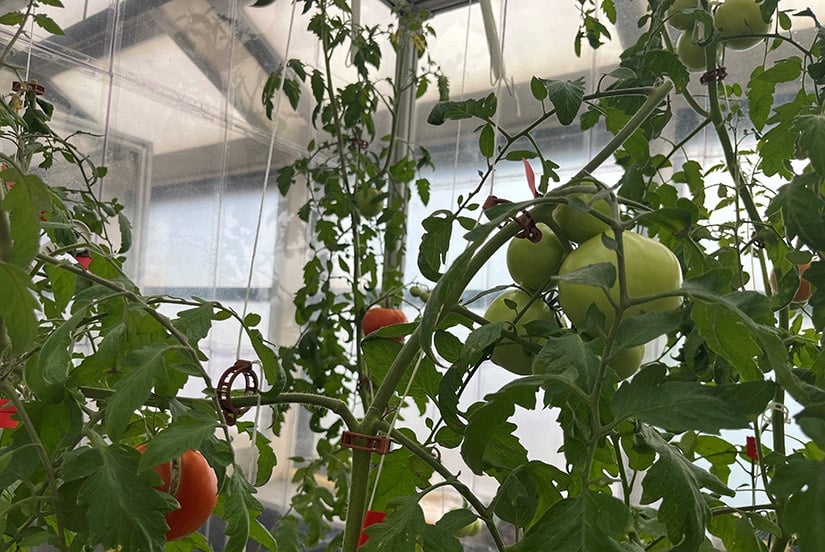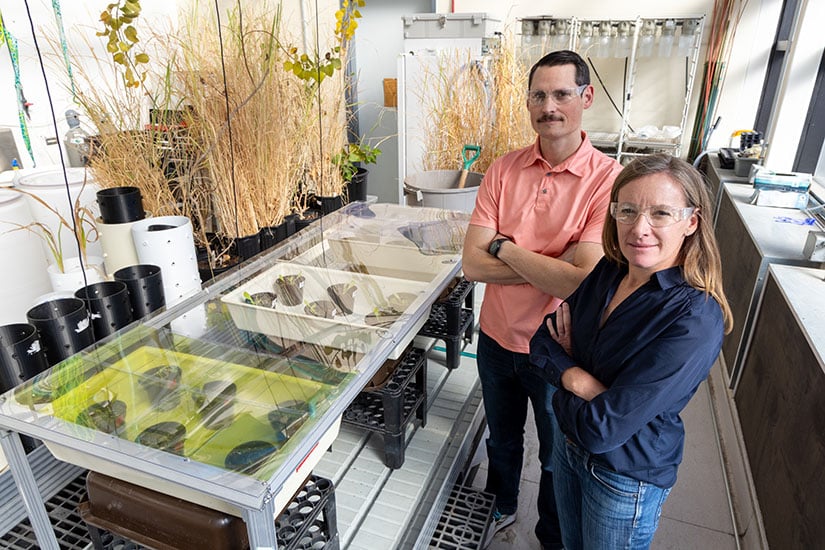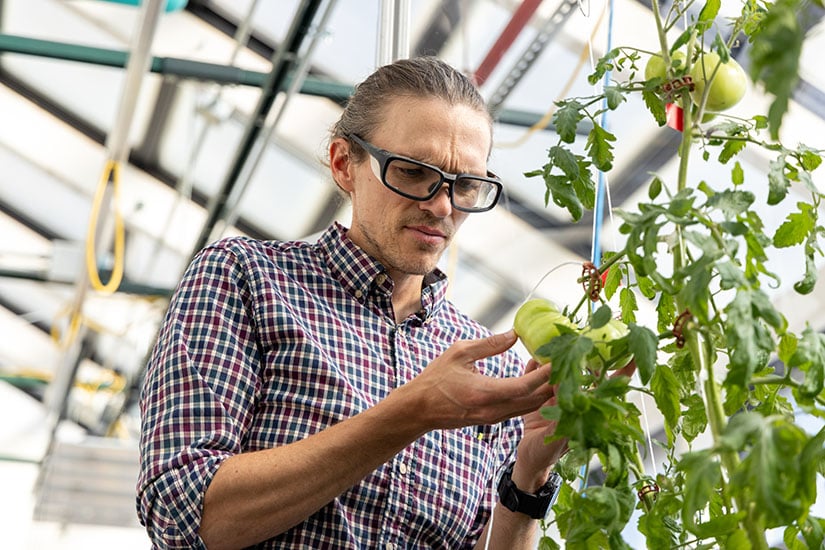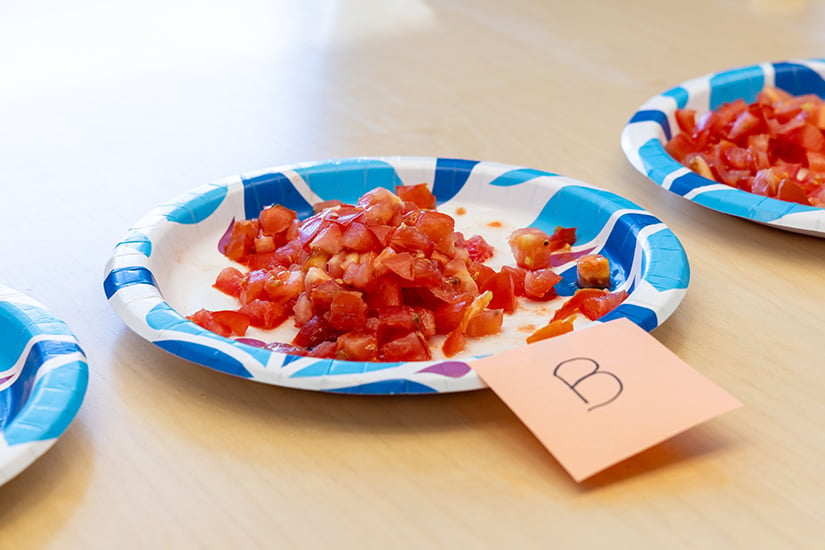Solar Panels Give Edge to Tomatoes Grown Underneath
Science Sometimes Ends With a Taste Test

Experiments lead to a greater understanding, deeper insights, and sometimes they even bear fruit. That was certainly the case last summer at the U.S. Department of Energy’s National Renewable Energy Laboratory (NREL), where researchers nurtured a dozen tomato plants.
Tucked into a corner on the second floor of the Field Test Laboratory Building, the plants were housed in two custom greenhouses. Six were exposed to the full solar spectrum, serving as a control to the six plants grown under less light. The reduced sunlight reaching the other plants was filtered through purplish panels so that only the spectrum most beneficial to the tomatoes would reach them.
The experiment was meant to prove the effectiveness of what is called a BioMatch, which enables the exact spectrum of light that best suits the physiological needs of the plant to pass through organic semiconducting materials found in solar cells. Now in the second year of the multi-disciplinary project known as “No Photon Left Behind,” the researchers determined limiting the spectrum made the tomatoes grow faster and bigger than those under direct sunlight.
“When light comes into contact with a plant, there are a lot of things that can happen. Different physiological pathways are triggered based on the type and amount of light. Those physiological pathways often determine productivity of the plant,” said Bryon Larson, an NREL chemist with expertise in organic photovoltaics (OPV) and principal investigator on the project. “We are studying what happens to plants when sunlight is filtered into only the spectrum and dose the plant needs, which is the plant light requirement, and we can produce that through the concept of BioMatched spectral harvesting, while using the light plants don’t need to make electricity with transparent OPV modules.”
Earlier Efforts Focused on Algae
Researchers grew the tomatoes adjacent to a lab space devoted to algae. In fact, the initial experiments on this project involved algae. They covered bottles containing the single-cell organism with a BioMatched photovoltaic filter intended to stimulate optimal growth. Rather than the months it takes to grow tomatoes, the work on algae proved fruitful over a single weekend.
Lieve Laurens, a plant biologist who heads NREL’s algae research, serves as the co-PI on the project. “We demonstrated that the cells grew faster, yielding more biomass, even though a large part of the spectrum was removed and the algae received fewer photons overall,” she said. “We found that photosynthetic algae had a much higher rate of converting photons to electrons to biomass, so it was great. So naturally we asked the question if the same effects would translate to plants and crops, where you could get the same yield with only the light spectrum the crop needs, without needing to bounce back the light it doesn’t need as wasted photons.”
Those findings showed the science was sound, provided preliminary data, and gave the researchers confidence to make their pitch for funding from the Laboratory Directed Research and Development program. A dedicated greenhouse would have been ideal, but the scientists had to make do with the available space.

Photovoltaics capture sunlight and convert it to electricity. The OPV filters for the algae and the tomatoes do not generate electricity, but the eventual goal would be to incorporate BioMatched materials into semitransparent solar panels that supply power to a greenhouse while letting plant light shine through.
“When full spectrum light shines on a plant, the light contains both productive and damaging photons, and plants have to deal with un-needed light by expending energy to protect itself,” Larson said. “Algae have to do that. Regular plants have to do that. If you were to take the useful vs non-useful wavelengths of light that you need to separate out, collect the non-useful part for electricity and send the other bit through for plant growth, you've now designed a system that's overall more efficiently using solar energy because it's spectrally binning it into different functions—plant growth through photosynthesis versus electricity generation through photovoltaics. This is a unique element of our work, hence, No Photon Left Behind.”
The makeshift greenhouses each stand about eight feet tall, four feet wide. The sunlight coming into the room appears from a wall of windows behind the plants and skylights above them. Three evaporative coolers on the roof keep moist air circulating. A refrigerator sits on the other side of the room, filled with ripe beefsteak tomatoes. Many are the size of a baseball. The tomatoes won’t win any prizes for looks; they were plucked on a schedule, which gave the skin on some of the fast-growing fruit time to split.
Seth Steichen, a biologist who works with Laurens, has kept a close watch on the tomatoes, assisted by Kelly Groves. They have seen the plants grown under the OPV BioMatched Light stretch higher than the neighboring plants treated to full sun exposure. Even though the control plants receive 30% more light, the OPV plants are selectively bathed in the slice of the solar spectrum they crave.
“For laboratory experiments, these particularly bright tomatoes are pretty much unheard of,” Steichen said. “Basically, no one does lab experiments on these. Because of their size, their relatively long lifecycle, those are the reasons why they're not commonly used for lab experiments. These are the most commonly grown variety of tomato in greenhouses in the U.S., so that is the reason why these are growing here right now, to make the most real-world connection possible.”
The regularly conducted tests considered such factors as size, weight, and photosynthetic yield, which measures how well the plants convert light into biomass. The tomatoes grown under BioMatched filters came out ahead.
“By and large, these are slightly more efficient in terms of photosynthetic yield than the control plants,” Steichen said, gesturing toward the plants under the filtered light. “The overall concept here is that you can still remove some of the light and convert it to electrons while still maintaining the same amount of fruit yield. This is just a test of whether or not that works with this given light-filtering chemistry, basically.”

Plants Absorb Light To Fuel Growth
The most widely used solar cells are inorganic and made from a singular material, specifically silicon. But NREL researchers have been pioneering work in solar cells based on organic semiconductors, which are made using synthetic chemistry. These organic photovoltaic devices have shown promise and potential to produce highly efficient cells that are also flexible, lightweight, and inexpensive.
Larson has accumulated a database of organic semiconductor properties during his more than 15 years at NREL, which allows him to select—or BioMatch—compounds that will produce the right spectrum for a particular plant. Plants convert light to chemical energy needed for growth. After calculating the amount of light a plant needs, the team uses a software program they created to generate BioMatch compositions based on a given plant light requirement. The team then scales up thin-film deposition processes to produce appropriate filters to allow only the desired spectrum to reach the plants. To show the reverse is also true, they have shown the anti-BioMatch filters will quickly starve a plant of light.
“I was worried when summer arrived nine months into the project, ideal conditions for tomato experiments,” Larson said about the shift from experimenting with algae. “What if we’re taking too big of a jump going from these single-cell organisms to far more complicated multicellular plants?”
But being able to put the BioMatch concept to test against growing tomatoes, he said, “is a bit of a dream come true. I mean, the fact that we got to grow tomatoes in the first year was way ahead of what the project was originally drawn up to do.” The confidence gained from experimenting with model algae strains convinced the researchers to take advantage of the summer growing season right then rather than wait until the second year of the project.
“When you’re doing experiments that rely on the weather, you don’t have much of a choice but to ‘make hay when the sun is shining’ as they say,” Larson said. “It was a choice to pull forward the experiment. Not wait for it. It panned out.”
The research could play an important role in the emerging field of agrivoltaics, in which various plants are grown near and beneath rows of solar panels, or help design next-generation energy-efficient greenhouses. The panels can be tailored to BioMatch the ideal light spectrum a plant needs, regardless of what species, or where on the planet you want to grow it, within reason.
The BioMatching OPV team included Reilly Seban, Jared Musci, David Moore, Amanda Behmer, and Mickey Wilson.”
But How Do They Taste?
With the experiment concluded that revealed the tomatoes grown beneath the OPV had accelerated growth, one final test had to be conducted.
“We’ve been all just licking our lips, waiting for the taste test,” said Larson, adding that he would be “personally very sad” if the tomatoes turned out to be tasteless given how promising the plants appeared by eye. The light reaching the tomatoes activates different functions, such as making sugar to sweeten the fruits and proteins to change the texture. “The taste test will be the final hurrah.”

Science demands variables, so Larson purchased organically grown industry reference greenhouse tomatoes as part of the test. He chopped up the various tomatoes, put them on plates, and mixed them up so even he could not tell which were which. Only the labels on the bottom of the plates held the answer. The researchers tried the tomatoes by themselves, with some salt, with some pepper, with some crackers, and then ranked each in order of preference.
The store-bought tomatoes came in last place. The consensus was split between whether the tomatoes grown under the OPV were a favorite, or the control tomatoes grown under regular sunlight. Larson said he took those results as a win for Steichen and the biology team, who were responsible for caring for the tomatoes six days a week for nearly five months.
With the initial experiment completed, and tasty at that, the researchers are on their way to a greater understanding of the interplay between light and plant growth.
Learn more about NREL’s research in the areas of bioenergy and bioeconomy, organic photovoltaic solar cells, and agrivoltaics.
Last Updated May 28, 2025
